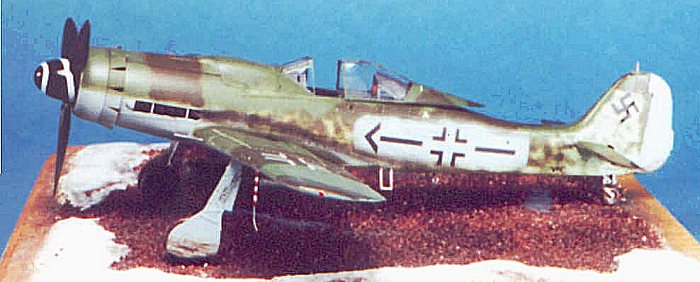
|
KIT: |
Tamiya 1/48 Fw-190D-9 |
|
KIT # |
61041 |
|
PRICE: |
$15.00, in the mid-1980s |
|
DECALS: |
See Review |
|
REVIEW & |
|
|
NOTES: |
Eagle Editions and Bruce Radebaugh Correction Sets Used |
THE TANK-BUSTER'S DORA-9
|
HISTORY |

Few modelers can fail to be unfamiliar with the Focke-Wulf Fw-190D-9, the ultimate development of the "Wurger," or "Butcher Bird," under its manufacturer's designation. Seen by its designer as an "interim" type as he continued to try and obtain official permission to use a Daimler-Benz powerplant, the Fw-190D-9, known also as the "Dora-9" or the "Langnasen Dora," was described by no less an authority than Chuck Yeager as "the best German piston-engine fighter I ever flew," from his days at Wright Field immediately after the war when he participated in the flight testing of captured enemy aircraft.
 The Dora-9
was the result of an attempt by Kurt Tank to improve the high altitude
performance of the design. The radial-engined A model rapidly lost power and
performance at altitudes above 20,000 feet. By 1942, this was seen as a
potential difficulty, since U.S.A.A.F. bombers generally flew at 24-28,000 feet,
and the Focke-Wulf fighter with its heavy armament was seen as the primary
bomber destroyer in comparison with the Bf-109. Powered by the Junkers Jumo
213A, a bomber engine (which was why Tank didn't like it), the resulting fighter
had a best altitude of only 25,000 feet - better than its predecessors, but not
what was really wanted. However, the rest of the performance envelope was
greatly enhanced, and the type entered production in the summer of 1944. The
first combat unit to become operational was III/JG54 in October 1944.
The Dora-9
was the result of an attempt by Kurt Tank to improve the high altitude
performance of the design. The radial-engined A model rapidly lost power and
performance at altitudes above 20,000 feet. By 1942, this was seen as a
potential difficulty, since U.S.A.A.F. bombers generally flew at 24-28,000 feet,
and the Focke-Wulf fighter with its heavy armament was seen as the primary
bomber destroyer in comparison with the Bf-109. Powered by the Junkers Jumo
213A, a bomber engine (which was why Tank didn't like it), the resulting fighter
had a best altitude of only 25,000 feet - better than its predecessors, but not
what was really wanted. However, the rest of the performance envelope was
greatly enhanced, and the type entered production in the summer of 1944. The
first combat unit to become operational was III/JG54 in October 1944.
By 1945, the Dora-9 was in widespread use in the Luftwaffe. The Fw-190D-9/R-5 development was a ground-attack variant that had much the same operational capability as the Fw-190F-8, being capable of using two wing racks on each wing for carrying SC50 bombs, and an SC250 bomb on the centerline rack. Several D-9s - some of which may have been the R-5 subvariant - were issued to SG2, which was at that stage of the war engaged in a rearguard action in Hungary and Czechoslovakia against advancing Soviet armies; their primary task was provision of air support to the remaining Ju-87G Stukas and Fw-190Fs of the unit.
Hans-Ulrich Rudel:
Legendary Stuka pilot Hans-Ulrich Rudel was the most decorated member of the Luftwaffe, being the only German soldier to receive the Golden Oak Leaves to the Knight's Cross with Diamonds. During his career as a Stuka Pilot on the Eastern Front, Rudel sank the Soviet battleship "Marat," a cruiser, a destroyer, and over 70 landing craft; in land battles, he destroyed over 500 enemy tanks, 800 soft-skinned vehicles, 150 pieces of artillery, and four armored trains, in addition to numerous bridges. He was the foremost exponent of the Kannonenvogel, the Ju-87G development of the Ju-87D, armed with two 37mm cannon underwing. He became Geschwaderkommodore of Schlachtgeschwader 2 in 1943, and continued to use the Stuka after it had disappeared from all the other Schlachtgruppen as other than a night attack aircraft.
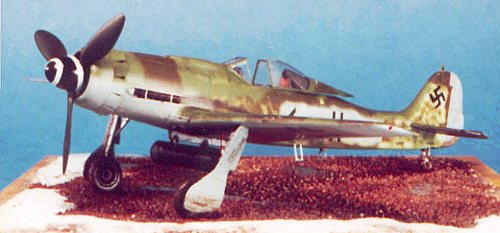 In March
1945, Rudel was badly injured in the crash landing of one of his Stukas, and
broke his leg. An indomitable fighter, he finally allowed himself to be talked
into flying the Fw-190 due to the fact the control forces were less than with
the Stuka, which allowed him to fly his Fw-190D-9 while still in a full leg
cast. During these final weeks of the war, Rudel added to his wartime record by
shooting down 9 Soviet fighters.
In March
1945, Rudel was badly injured in the crash landing of one of his Stukas, and
broke his leg. An indomitable fighter, he finally allowed himself to be talked
into flying the Fw-190 due to the fact the control forces were less than with
the Stuka, which allowed him to fly his Fw-190D-9 while still in a full leg
cast. During these final weeks of the war, Rudel added to his wartime record by
shooting down 9 Soviet fighters.
Rudel's reputation would be less odorous had he died in combat in 1945. He was one of the few members of the Luftwaffe during the war to be a professing Nazi and a believer in the propaganda written about himself by Goebbels. Rudel remained an unreconstructed Nazi after the war, with pretensions to becoming the new Fuehrer when he participated in the founding of the National Democratic Party - the neo-Nazis - in the 1960s, activity he remained deeply involved with until his death in the early 1980s; he was the only individual with any sort of national reputation to be involved with the organization and was their public "star." Re-reading his book, "Stuka Pilot," one can easily see the pro-Nazi references throughout, such as his claim to have been "fighting for freedom" on the Eastern Front.
|
THE KIT |
Tamiya's Dora-9 was first released in 1995, following on to the release of
the Fw-190A-3 and Fw-190F-8. Unfortunately for Tamiya, they chose the Fw-190D-9
at the Air Force Museum in Dayton, Ohio, to use as their pattern aircraft. The
reason this was unfortunate is that, back in 1948 when no one paid much mind to
such things as the differences between sub-types, the Air Force had a
disassembled Fw-190D-9 and Fw-190D-13 at Freeman Field, Indiana; when asked to
provide one for an airshow in Atlanta, the wing of the Fw-190D-9 was attached to
the fuselage of the Fw-190D-13 and sent to the show, while the other fuselage
and wing were sent to the Air Force Museum for later restoration. The result is
that the Fw-190D-9 Tamiya used has an Fw-190D-13 wing, which is considerably
different in detail from the correct wing. (This is reminiscent of Tamiya's
run-in with the Cosford Meteor, an F.1 fuselage 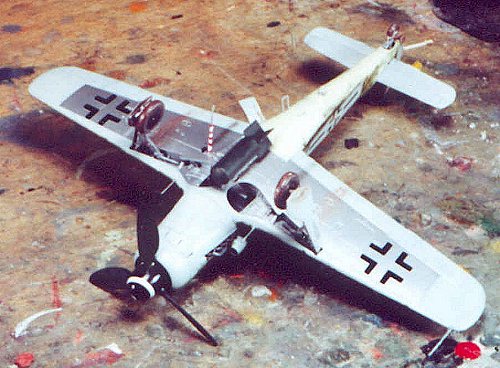 mated to an F.3 wing, again
considerably different in detail from the correct item.) Additionally, Tamiya
came up with a propeller and spinner that look nothing like anything ever used
on an Fw-190D-9, wheels that are too small, an upper gun bay cover that is
misshapen, and landing gear legs that are 6 scale inches too short, making for a
strange "sit" to the final result.
mated to an F.3 wing, again
considerably different in detail from the correct item.) Additionally, Tamiya
came up with a propeller and spinner that look nothing like anything ever used
on an Fw-190D-9, wheels that are too small, an upper gun bay cover that is
misshapen, and landing gear legs that are 6 scale inches too short, making for a
strange "sit" to the final result.
Fortunately, the Dora-9 is one of the most popular kits around, so several aftermarket companies have made resin correction sets for this. Among the best are those designed by Bob Stephenson, some of which are marketed by him as The Wurger Mechanic, and some of which are marketed by Jerry and Judy Crandall at Eagle Editions. For this kit, I chose to use the Eagle Editions correction set, which includes a resin fuselage gun cover and upper cowling deck, and a resin prop and spinner the correct size and shape. I had the now out-of-production SuperScale sheet, 48-549 "Fw-190D-9 Aces," which has the markings of Rudel's airplane, so I was set for my project.
|
CONSTRUCTION |
Of the two Fw-190D-9 kits available in 1/48 - that made by Trimaster originally and later released by DML, Italerei and lately by ProModeler - and this Tamiya kit, the latter is by far the easier kit to assemble, due to Tamiya's legendary kit engineering. The resin correction parts, originally produced by Bob Stephenson, are so good they can be substituted directly for the kit parts and used accordingly. Like most Tamiya kits, the model falls together.
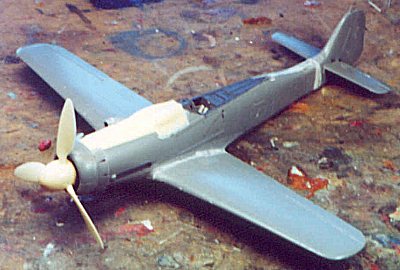 The only
thing I did differently was to cut open the wheel wells, which were not closed
in on the Dora-9 as they were for the earlier Anton series. This means
you will see the engine. Fortunately, I had Bruce Radebaugh's resin correction
set, which includes a resin engine plug, as well as the corrected lower wing
panel so that you have the two inner shell-ejection chutes which are correct for
the Dora-9, rather than the single ejection chute in the kit part, which is
correct for the Dora-13.
The only
thing I did differently was to cut open the wheel wells, which were not closed
in on the Dora-9 as they were for the earlier Anton series. This means
you will see the engine. Fortunately, I had Bruce Radebaugh's resin correction
set, which includes a resin engine plug, as well as the corrected lower wing
panel so that you have the two inner shell-ejection chutes which are correct for
the Dora-9, rather than the single ejection chute in the kit part, which is
correct for the Dora-13.
The cockpit was painted RLM66 dark grey before assembly, with the instruments and various buttons picked out in different colors to add some detail to the look of the cockpit. I used Eduard photoetch seat belts. I found when I test-fitted the resin engine plug that I had to cut off the front bulkhead of the cockpit, back about 1/16". I used a piece of thin sheet plastic to block off the new opening, since you would be able to see light through the wheel wells looking into the cockpit otherwise. The engine was painted black and dark grey, with various lines in other colors to add to the look then installed, and the fuselage was closed up. The rest of the assembly was as straightforward as one normally expects from a Tamiya kit. I only used Mr. Surfacer 500 to fill the centerline seam.
|
PAINT & DECALS |
Painting:
By this stage of the war, German airplanes were getting "interesting" as regards painting, because they were using less, were using other colors, and were not always using them as prescribed. This is particularly true with the lower surfaces.
By 1945, a new lower camouflage color, now called "RLM84" had come into use. This is a color close to RAF "Sky." From what I have seen from the color gurus, I choose to use Gunze-Sanyo's "Sky" color, which is more yellow than Tamiya's, and looks closer to the photographs of the only Luftwaffe airplane left which has this original color on it. This was used interchangeably with the earlier RLM76 Blue-grey, during the sub-assembly process. Thus, it is possible to get an airplane with a cowling in RLM76, center fuselage in RLM84, natural metal Fuselage extension, tail surfaces in RLM84, and control surfaces - ailerons, elevators and rudder - in RLM76, in addition to some large portion of the lower wing, the wheel wells and the landing gear left in natural metal, partially painted in RLM75 Gray-Violet, etc.
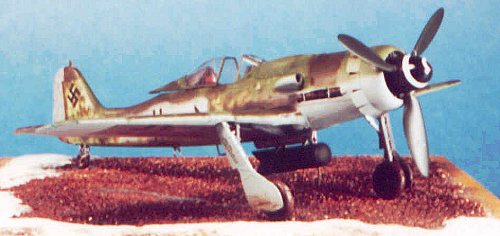 There is one
photograph of Rudel's Dora-9, and it is not very clear. You cannot tell if it is
carrying the underwing racks, since those are in shadow. It is clear that the
forward fuselage lower color and the rudder are the same, and the central
fuselage is a different color. For mine, I chose to do the cowl, rudder,
ailerons and elevators in RLM76, and the central fuselage in RLM84; this seemed
correct when I looked at the difference in tonal quality between the central
fuselage lower surface color and the oversprayed area where the national
insignia and Geschwaderkommodore's insignia were placed - I used RLM76 for this
overspray. On the underside of the wing, I left the center spar section, the
gear well and the landing gear in natural metal, with the forward part of the
lower wing in RLM76 - this could also have been RLM75, and further could have
been done in the pattern of having the forward half of the wing painted and the
rear half unpainted; I made my choice from a photo of an Fw-190F-8 turned up on
its nose on a scrap pile after the war.
There is one
photograph of Rudel's Dora-9, and it is not very clear. You cannot tell if it is
carrying the underwing racks, since those are in shadow. It is clear that the
forward fuselage lower color and the rudder are the same, and the central
fuselage is a different color. For mine, I chose to do the cowl, rudder,
ailerons and elevators in RLM76, and the central fuselage in RLM84; this seemed
correct when I looked at the difference in tonal quality between the central
fuselage lower surface color and the oversprayed area where the national
insignia and Geschwaderkommodore's insignia were placed - I used RLM76 for this
overspray. On the underside of the wing, I left the center spar section, the
gear well and the landing gear in natural metal, with the forward part of the
lower wing in RLM76 - this could also have been RLM75, and further could have
been done in the pattern of having the forward half of the wing painted and the
rear half unpainted; I made my choice from a photo of an Fw-190F-8 turned up on
its nose on a scrap pile after the war.
I did the upper camouflage in RLM82 Bright Green and RLM83 Dark Green, using the Gunze-Sanyo colors. The spinner is black and the blades are RLM70 Black-Green.
Decals:
I used the kit decals for the stenciling, and the SuperScale decals for the national insignia, personal marking, and the "corkscrew" on the spinner. There were no problems.
Final Assembly and Weathering.
 I had
lengthened the landing gear legs 1/8" to get the proper length. This meant
the brace didn't fit, so I trimmed off the fit peg and attached the brace to its
proper place on the gear leg, then let it "fall to fit" in the gear
well; it's actually too short also, but fixing that was more than I cared to do
at the moment.
I had
lengthened the landing gear legs 1/8" to get the proper length. This meant
the brace didn't fit, so I trimmed off the fit peg and attached the brace to its
proper place on the gear leg, then let it "fall to fit" in the gear
well; it's actually too short also, but fixing that was more than I cared to do
at the moment.
As far as weathering was concerned, I assumed this airplane didn't spend enough time in the field before the war ended to get really dinged around, though it would have gotten mud-smeared, and smeared with exhaust and gunfire residue. The "mud" was dry-brushed on the wheels and immediately behind the wheels on the lower wing and the rudder to simulate mud spray, while the gunfire residue and exhaust stain were done by airbrushing Tamiya "Smoke."
Once this was all done, I airbrushed three coats of "Flat Future" over the whole model except for the natural metal lower wing area, then unmasked the canopy and attached it in the open position. I used invisible mending thread for the antenna, letting it fall to the side which is the way the antenna works with the blown hood on the late Focke-Wulfs.
|
CONCLUSIONS |
A month ago, I had one Fw-190D-9 in my collection and didn't think that much about it. With these resin correction sets, the kit takes on an entirely different look. With the upcoming Fw-190D-11 conversion, D-13 conversion, early version conversion, etc., etc., I will be starting my own Butcher Bird air force! And I will be having fun doing them all.
To obtain the Eagle Editions Fw-190D-9 resin correction set, visit their website at: http://www.eagle-editions.com
To obtain Bruce Radebaugh's engine plug and lower wing correction, e-mail him at: bradebau@netzero.net
If you would like your product reviewed fairly and quickly by a site that averages over 2,200 visits a day, please contact me or see other details in the Note to Contributors.